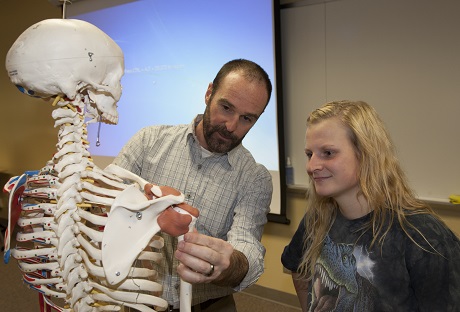Champions of Well-Being
Exercise Science program at COCC coaches students on the world of wellness
Three skeletons roll into a classroom. That’s not the set-up for some groan-inducing
punchline, it’s how an anatomical kinesiology class gets underway at Central Oregon
Community College (COCC), as John Liccardo, associate professor in the Health and
Human Performance department, arrives with skeletal models in tow. Soon his students
are clustered up, gamely involved in a task: They take turns thinking of a bone, then
describe its location using anatomical terminology as a way to clue-in classmates.
“I’m looking at something that’s posterior to the sternum…it has lots of muscle attachments,”
a female student communicated to her group, slowly spooling out hints. They make guesses,
zero in. The interactive lesson is fun and instructive—a bone touched becomes a bone
learned. The skeletons look on good-naturedly.
Also looking on is Liccardo, observing newfound knowledge in action. “This class
is really fun, people get to move,” he said, alluding to how students’ own body movements
help inform their educational process. That “moving” aspect of the class, explained
the former NCAA Division I athlete, is a core part of learning for these future occupational
therapists, physical therapists and personal trainers, all students of COCC’s exercise science program.
While math and science skills are fundamentally wired to the discipline, the program also fosters a person-to-person nature. It’s a career track that speaks to athletes, health-minded individuals and those who simply want to make a difference.
Exercise science is certainly a field on the move. In an era when people are embracing wellness and fitness more than ever, and as health science continually takes new strides, the role of exercise science has gone increasingly mainstream.
At COCC, exercise science students can take one of two academic paths: an Associate
of Science degree (which also aligns with the pursuit of a Bachelor of Science in
kinesiology at OSU-Cascades) or a more generalized Associate of Arts Oregon Transfer degree, an “all-purpose” ramp-up to a bachelor’s degree in a variety of subject areas. Physical
therapy, for instance, is a field that requires a bachelor’s degree.
Coursework includes wellness coaching, sport psychology and training theory, among
others. The college’s resources for learning include an advanced physiology lab, where local athletes of all caliber come for fitness evaluations and students get
hands-on experience with VO2 max monitoring and athlete assessments.
It’s an education that delivers on two levels: Students not only learn skills applicable
to their chosen career, but they also discover good-health concepts and practices
to assimilate into their own lives.
That reality played out in one of Jenny Cruickshank’s recent wellness coaching classes,
where the assistant professor unpacked—and quickly discarded—the notion that failure
is a bad thing.” “I’m going to encourage you to think about the ‘failing forward’
idea,” said Cruickshank, a nationally board-certified wellness coach, encouraging
her students to view swings and misses as a platform for growth. Part of her lecture
for the day centered on the power of the bucket list, how a written set of goals can
trigger a far-reaching wellness boost.
New data, she shared, suggests that people with depression and chronic health issues,
even traumatic brain injuries, are benefitting from the goal-oriented technique. Yes,
crossing things off a list releases feel-good dopamine and serotonin, she added, but
the mere intention creates a deeper impact.
“Just writing it down validates it,” said a male student. “Yes!” Cruickshank replied.
With her open, encouraging manner (and an occasional high-five), Cruickshank was making
an impression.
For former student Ally Galloway, who owns and operates BodyRock, a training and
fitness studio, that impression has endured. “One of the things that makes the program
so strong is their dedication,” she said of the exercise science faculty. “They’re
so knowledgeable and so invested in what they are teaching. They care about their
students, and their students’ success, long after the classes end.”
For more details, visit the Exercise Science program at Central Oregon Community College or call 541-383-7700.
By Mark Russell Johnson, COCC College Relations

